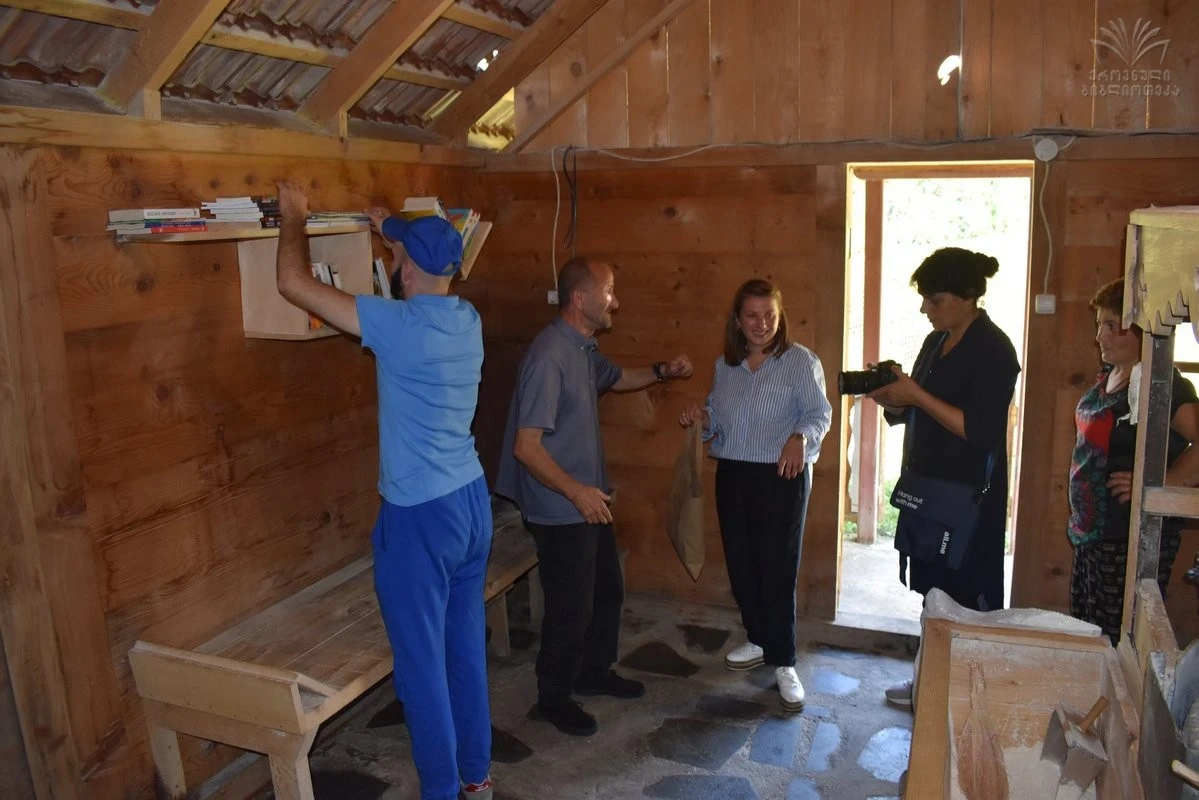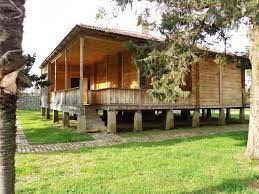[:en]I warn you in advance, there is a long and pleasantly exhausting journey ahead of us. I will not bore you and list the places to visit: Didi Van, Noah Jordan, Karel the Lion Temple, Zemosuri, Shuagora Jaji lake.
We will stop at Guri Lake for the first time. Before telling you about it, I will list the lakes of Guria. Until now, I knew the existence of four lakes in Guria (Paliastom, Grigoleti Lake, Japani, Jaji and Chinchao lakes, the main and most important of which is Paliastom Lake, about which Egnate Ninoshvili wrote an extraordinary story, whose house-museum is in Lanchkhuti municipality).
Guri Lake is located at the junction of Bukissikhi and Yaneuli villages, and I read this story in the annotation of a very tasteful video, authored by Giviko Didia. If you believe me, you should often visit Mr. Giviko’s official pages, you will find very interesting videos, not only about Guria tourism.
Tamar Castle includes several construction layers, from the early Middle Ages to the late Middle Ages. In 1774, Bukissikhe along with Likhauri Castle and Askani Castle were captured by the Turks. In the same year it was taken back by Mamiya IV Gurriel and Solomon I. Tamari Castle controlled the road from Imereti and Meskheti to the Black Sea before Guria joined Russia. Today, the monument is very damaged, only the north-eastern part of the castle remains. On the first floor of the multi-storied tower on the north side of the building, a large stone press and the remains of a stone staircase were discovered. The second floor should be residential, and the third floor – military. It is dated to VI-VII centuries. A 10th century church was built to the east of the castle, of which only the northern and eastern walls have survived. The entrance to the temple is from the west. The sanctuary is rectangular. The inside of the monument is paved.
We will visit Didvan directly from the Tamar Castle. Based on the data of the Georgian Wikipedia, we can confidently say (I don’t like the word “declare”): Didivan, Vani — a community in Chokhatauri municipality, formerly Kvemo Suri. It includes the villages: Gagma Dobiro (my ancestors were also from Dobira, but from Lanchkhuti; Dobira itself is the mouth of the river in Guri, it has a different definition in non-Gur, but let’s not violate the borders and stay in Guria) Gagma Dobiro, Guristke. It is located in the valley of the Sufsi river.
Noe Ramishvili was born in Didi Van on April 5, 1881. We will visit his house-museum and learn Mr. Noe’s biography on the spot. .
In April 1918, he was appointed the Minister of Internal Affairs of the Transcaucasian Democratic Federal Republic; On May 26 of the same year, he was elected as the first chairman of the provisional government of the newly created Democratic Republic of Georgia. On July 24, he was replaced by Noe Jordania, Noe Ramishvili remained the Minister of Internal Affairs of Georgia, at the same time he was the Minister of War in 1919. Reorganization of the army, reform of the school, development of the field of communications were carried out under his leadership, he paid special attention to Tbilisi University.
The next stop is Sveti Giorgi of Sureb “Lomi-Karelia”. According to “Guria Moambi” (January 22, 2023), “The icon of St. George “Lomis-Kareli” is known for its special power in Guria, which rests in the church of the same name in the community of Sureb” Taras Mamaladze wrote in his ethnographic notes.
According to the same information, the victims would “blame” before the icon, i.e. “hand over” the criminals to the icon, and if someone was guilty, the icon would punish him and his descendants. The lion-carel represented a cross, its height was one cubit, and its width was two cubits, and it was completely covered with silver. According to Grigol Uratadze, the Lomis-Karel icon was brought from the ancient church of Lomis.
Let’s talk about Grigol Urotadze another time.
I am going to make a virtual visit to Zemosuri, but before that I want to give a belated thanks to my close relatives. As soon as the first part of the trilogy was published, I was introduced to Mr. Jackeli’s name (Samson!) mentioned there.
As for me, I would like to know the following about the Church of St. George of Shua Sur, called Lomiskarel (I use the Georgian Wikipedia as a source):
The temple belonged to the Eristav-Sharvashidze family. Davit Sharvashidze and his brother Zaal gave the flock of St. Giorgi Lomiskareli to the Trapaidzes. Anizdar Trapaidze renewed the cross of Lomiskareli. The icon of Lomiskareli, a miracle worker according to the locals, was kept in the temple. If someone lost or stole something, he would hand over the culprit to this icon. Later, the icon of Lomiskareli was resting in the village of Bukisikhe, from where it was kidnapped during the revolution of 1905.
The hall church is made of wood. It is based on the preparation of stone, the surface of which is paved with rectangular flat tiles, and the latter is the floor of the church. Five windows are cut on the five-sided fine apse. On the three front gables, there are cut-out windows decorated with plain wooden capitals. On the sides there are Marathi corner windows, the heads of which are painted with plant ornaments. In addition to the windows in the apse, the interior is illuminated by the light coming from the doors and two windows on all three sides. In the center of the interior there are two cantilevered columns on which the weight of the roofing structure is distributed. A five-step staircase connects to the stone platform at the southern entrance of the church. On the same platform, there are four fluted columns, based on stone bases, which support the roof.
The next stop is Shuagora. Shuagora is a resort located above the Shurebi valley and is known for two attractions: the first is the “King’s spring”, the second is the “Jadji” lake. If we believe the Georgian Wikipedia (what right do we have not to believe?!):
Mefistskaro is a mountain in Georgia, on the administrative border of Van and Chokhatauri municipalities. It is the highest peak of the Meskheti mountain range. Height above sea level is 2850 m. It is located at the confluence of the Meskheti ridge and its northern branch – the Lobyul ridge, at the headwaters of the Supsi and Tsablariskali rivers. It is pyramidal. It is built with middle Eocene, andeitic layers, tuff-breccias and tuff-conglomerates. The base and lower slopes of Mefistskaro are covered with subalpine lich, middle and upper – alpine meadows.
It’s time to turn to Georgian Travel Guide and provide you with valuable information.
Information about Big and Little Jaji Lakes:
Big Jaji Lake (at an altitude of 2655 m, mirror area of the lake 0.01 km², maximum depth of 5 m) and Little Jaji Lake (at an altitude of 2630 m, mirror area of 0.007 km², maximum depth of 3.2 m.).
The lakes between the mountains are fed by snow, rain and underground water. From here, the highest peak of the Meskheti range, Mefistkaro, can be seen in all its glory. For reference: the best resorts of Guria are located on the ridge of Meskheti – balneological Nabeglavi, climatic Bakhmaro and Gomismta. Judge Lakes is the best place for camping, hiking or horseback riding. One of the interesting routes is Chokhatauri-Surebi-Mefitskaro-Jaji lake.
If you are looking for an unforgettable adventure, visiting the Jagji Lakes is truly the best experience, I have no doubt about that!
p.s.
Recently, I reviewed a large section of the “Chokhatauri-Jajji Lake” strip. Another “blog”. I mentioned it in the title and I will repeat it here – I have temporarily finished writing about Chokhatauri attractions. I don’t know if you will believe me or not, but I confirm it – my heart broke. How much there is to say, how much there is to see… how much to write and how much to photograph…
I will return to Chokhatauri,,, well, what will I do?!
The fact is, I fell in love with myself even more!!![:]
![[:en]Guri Lake, Tamar Castle, Noe Ramishvili and the temporary end of the well-started news[:ka]გურის ტბა, თამარის ციხე, ნოე რამიშვილი და კარგად დაწყებული ამბების დროებით დასრულება[:] post thumbnail image](https://guriatourism.com/wp-content/uploads/2023/11/e1839be183ace18395e18390e1839ce18394.webp)


